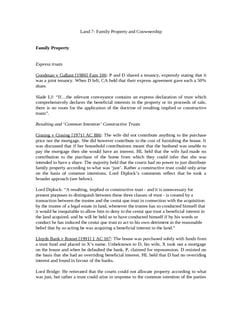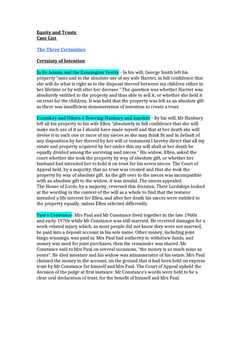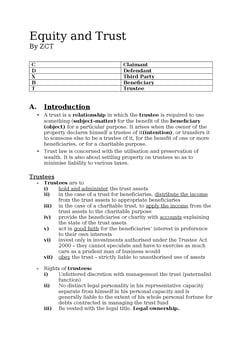Eves v Eves [1975] 1 WLR 1338; [1975] 3 All ER 768; [1975] 4 WLUK 68
Judgement for the case Eves v Eves
Table Of Contents
KEY POINTS
A constructive trust arises when a man and a woman engage in a joint enterprise of acquiring and maintaining property to live together.
In such a scenario, the inference from their conduct implies a mutual understanding that the woman should have a beneficial interest in the house.
Constructive trust is rooted in equitable principles, aiming to prevent unjust enrichment and ensure fairness in property ownership. In this context, the joint efforts of the man and woman in acquiring and sustaining the property created an implicit agreement that both parties shared an interest in the home.
The woman's beneficial interest in the property was recognized, and a constructive trust may be established to safeguard her rights to the jointly acquired residence.
FACTS
In 1968, Janet Eves (“Plaintiff”), under 21 and separated from her husband, began living with Stuart Eves (“Defendant”), who was also divorced.
After their daughter's birth in April 1969, they purchased a house for £5,600, solely in the Defendant's name due to the Plaintiff's age.
-
Despite the Defendant's assurance that it would be their joint home, he later claimed her age as a reason for the sole ownership.
The Plaintiff actively contributed to renovating the house.
A second child was born in December 1970, and though their prior marriages were dissolved, they didn't marry each other.
-
In 1972, the Defendant announced plans to marry another woman, eventually marrying her in December.
A court granted the Plaintiff custody and maintenance in 1973, but the Defendant failed to comply.
Threats led to the Plaintiff leaving the house.
In April 1974, the Vice-Chancellor ruled against the Plaintiff's claim for a share in the property, a decision she later appealed.
JUDGEMENT
-
Upon the Plaintiff's appeal, the court held, having allowed the appeal, that a trust had indeed been established.
This determination stemmed from the Defendant's actions, which had led the Plaintiff to believe she would have an interest in the house.
According to Lord Denning M.R., the property had been acquired and maintained by both parties for their joint benefit.
Browne L.J. and Brightman J. further supported this finding by asserting that the house's condition and the Plaintiff's substantial contributions to its improvement indicated an implicit agreement for her to contribute her labor.
Considering these circumstances, the court concluded that it should imply the Plaintiff's intent to acquire a quarter interest in the property.
A declaration was issued, affirming that Defendant held the legal estate in trust, with three-quarters for himself and one-quarter for Plaintiff.
The court also stipulated a postponement of any order for the sale of the house, provided the Defendant made reasonable provisions for the maintenance of the children and settled the arrears under the magistrates' court order.
COMMENTARY
Constructive trust emphasizes the mutual understanding between parties engaging in a joint enterprise to acquire and maintain property. It underscores the equitable principles aimed at preventing unjust enrichment and ensuring fairness in property ownership.
-
The case of Janet Eves and Stuart Eves provides an illustration of the complexities of constructive trust.
The narrative outlines the circumstances leading to the acquisition of the house, the Plaintiff's active contributions, and the subsequent breakdown of the relationship.
The Defendant's decision to claim sole ownership based on Plaintiff's age introduces a crucial element of dispute.
-
The court's decision reflects a nuanced understanding of the situation.
The acknowledgment of a trust being established is based on Defendant's actions leading Plaintiff to believe she had an interest in the house.
Drawing on equitable principles, the court considered the joint efforts in acquiring and maintaining the property as indicative of shared ownership.
-
The case example emphasizes examining the parties' conduct and intentions in constructive trust cases.
It highlights the court's role in rectifying potential injustices by recognizing and formalizing the equitable interests of the parties involved.
The case's specific details, such as the Plaintiff's contributions and the Defendant's subsequent actions, contribute to a comprehensive understanding of the court's decision to establish a constructive trust and allocate shares in the property.
For Further Study on Eves v Eves

Land Law notes fully updated for recent exams at Oxford and Cambridge. ...

A collection of the best GDL notes the director of Oxbridge Notes (an O...
Need instant answers? Our AI exam tutor is here to help.
Ask questions 🙋 Get answers 📔 It's simple 👁️👄👁️
Our AI is educated by the highest scoring students across all subjects and schools. Join hundreds of your peers today.
Get StartedRelated Product Samples
These product samples contain the same concepts we cover in this case.

 Since 2010, Oxbridge Notes has been a trusted education marketplace, supplying high-quality materials from top achievers at universities like Oxford, Cambridge, LSE, Harvard, and Yale.
Since 2010, Oxbridge Notes has been a trusted education marketplace, supplying high-quality materials from top achievers at universities like Oxford, Cambridge, LSE, Harvard, and Yale.